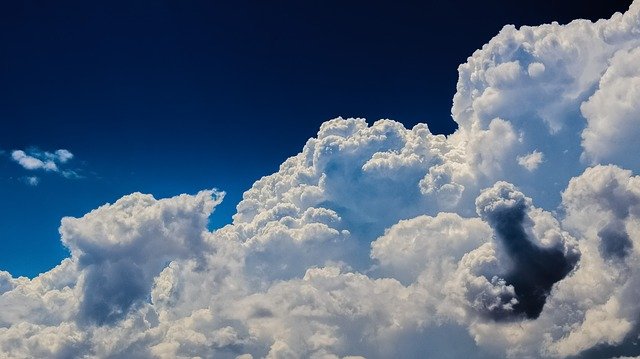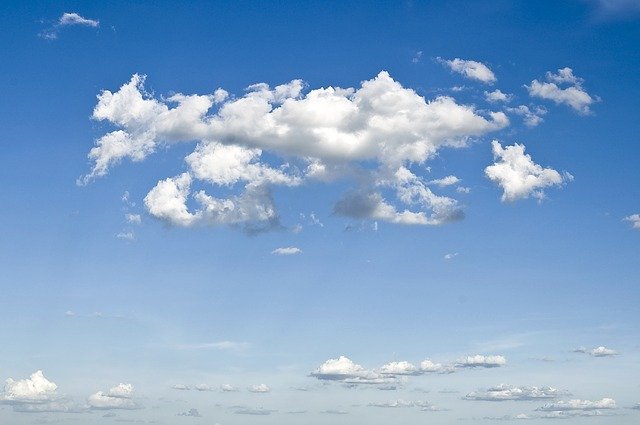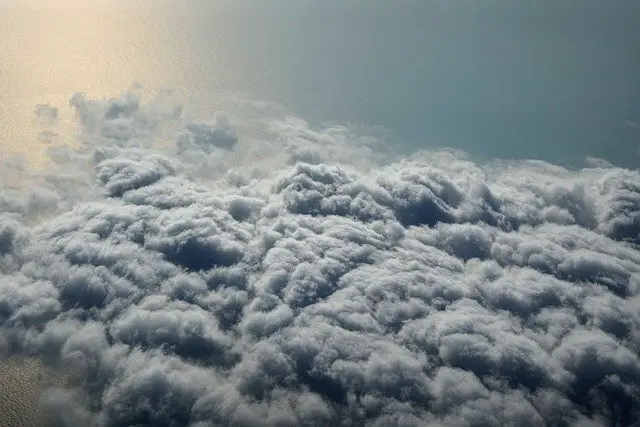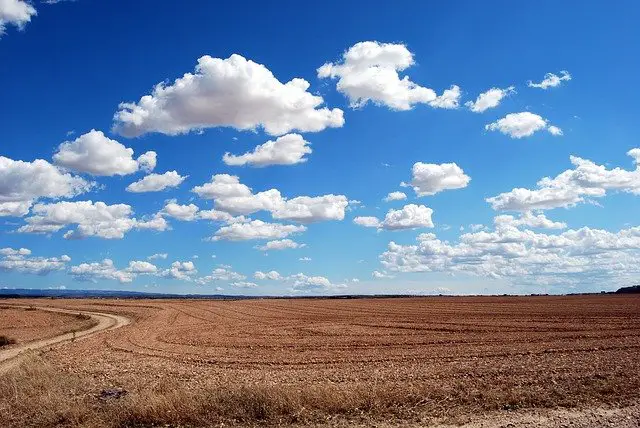On a humid day, we see clouds floating in the sky. Some clouds are white and sparsely scattered, while others are dark gray and heavy.
There are four major types of clouds; stratus, nimbus, cirrus, and cumulus.
Some clouds, such as stratus, form snow while others, such as nimbus, result in rainfall. Cumulus clouds appear like white bundles of cotton and indicate the absence of rain.
Are clouds gas or liquid? To answer this question, let’s look at the dictionary definition of clouds.
According to the Macmillan dictionary , ‘clouds are gray or white mass, made of tiny droplets of water that floats in the sky.’
From this definition, you can say that clouds are liquid. Does this apply to all types of clouds?
Let’s look at the process of cloud formation first.
How Are Clouds Formed?

When the water in water bodies and on land is heated by heat from the sun, water vapor is formed.
The water vapor rises to the atmosphere, where temperatures and pressure are low.
Water vapor condenses to liquid water at low temperatures. The liquid water droplets are held by air in the atmosphere.
The process of evaporation and condensation continues until there are enough water droplets that air can hold.
At this point, the air is saturated. Saturation in the air means that the air has the maximum amount of moisture it can hold at a given temperature.
When air is saturated, its relative humidity is 100%. If the air temperature rises, its relative humidity drops and can hold more water droplets.
Clouds are formed when air is saturated. The water droplets in the air coalesce to form clouds and other forms of precipitation like fog and snow.
Although the major component of clouds is moisture, it has traces of dust particles and salt from the sea.
At very low temperatures, some water droplets in the clouds freeze to ice crystals.
Categories of Clouds

There are three main categories of clouds:
- Low-level clouds which are formed at about two kilometers from the earth’s surface.
- Middle-level clouds which are formed at about four kilometers from the earth’s surface.
- High-level clouds which are formed at about 5-12 kilometers from the earth’s surface.
(i) Low-level clouds
Low-level clouds exist as tiny liquid droplets of water.
They are white and appear like thick bundles of cotton wool.
They include cumulus and stratus.
Low-level clouds indicate fair weather. When low temperatures, low-level clouds freeze to snow and fall to the earth’s surface as snowballs.
(ii)Middle level clouds
Middle-level clouds are composed of liquid water droplets.
Their appearance in color ranges from white to light gray.
They are thicker than low-level clouds.
They include altocumulus and nimbostratus.
Due to the low temperatures at high altitudes, they contain ice crystals within their structure.
Middle-level clouds form rain and hailstones.
(iii) High-level clouds
High-level clouds are formed at very high altitudes where temperatures are very low.
They exist mainly as ice crystals. They are white and appear as light feathers.
Cirrus and cirrocumulus are high-level clouds.
High-level clouds form rains only in high-altitude areas. They also fall as snow.
How are clouds cleared from the air?

So far, we have seen how clouds are formed and their categories depending on location and composition.
Most clouds in the low and middle-level category last for an average of six hours. High-level clouds such as cirrus may last up to 14 hours.
There are two ways by which clouds are cleared from the air.
- If the temperature in the air rises to a level that the water droplets absorb enough heat energy to evaporate, the clouds change to invisible water vapor, and the clouds are cleared. At this point, the air is no longer saturated and can hold more water droplets.
- If the temperature remains low, the water droplets in clouds become too heavy. The already saturated air cannot hold the heavy clouds anymore. They fall to the earth’s surface as rain, snow, hailstones, and sleet.
Cloud formation in the air and cloud clearance from the air is continuous processes. After clearing, more clouds are formed as more water vapor rises to the atmosphere.
The Verdict

Having looked at the cycle of clouds, how they are formed, what they contain, and how they are cleared from the air, let’s go back to our question: Are clouds gas or liquid?
From the dictionary definition, clouds are made of water droplets, implying liquid.
Apart from high-level clouds, mainly ice crystals, the rest of the clouds exist as water droplets.
From the formation of clouds, water vapor has to condense and become visible to be termed as clouds. This happens at high altitude areas where temperatures are low.
Given that the boiling point of water is 1000C, it can only be in liquid form at high altitudes where temperatures are as low as -500C.
Lastly, when clouds are cleared in the form of rain, it falls as liquid droplets and as snowballs.
All these characteristics of clouds and the conditions under which they are formed prove that clouds are liquid and not gas.

